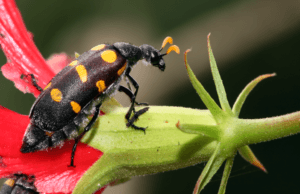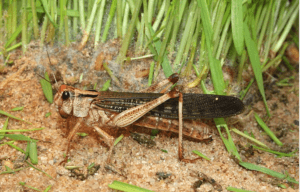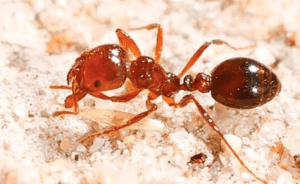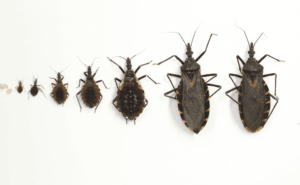Do you want to know the biggest insect in the world? From the deadliest disease spreader to the most voracious swarms, read along to discover the killer insects and the scary bugs!
You might fear a leopard or a gorilla, but do you know insects are actually the most dangerous animals in the world to humans? This is due primarily to the ability of insects to carry and spread diseases. And we all are familiar with the destruction malaria and sleeping sickness diseases have caused.
Deadly insects feed on the vertebrate’s blood, which is why they easily transfer nasty bacteria, viruses, and parasites from host to victim or victim to victim, as well as from animal to human. Ahh! This is a long story. Let’s look at the 10 biggest insects in the world to learn more about these killer insects.
Biggest Insect in the World
Don’t let the size of insects deceive you. Insects have created a lasting impact on human history. Their effects have contributed to human evolution, from devastating plagues to colonial expansions. The world’s deadliest insects are as follows:
- Blister beetles
- Locusts
- Assassin caterpillar
- Fire Ants
- Asian Giant Hornet
- Bees and Wasps
- Kissing bugs
- Fleas
- Tsetse Fly
- Mosquito
Largest Insect in the World
Read on to find the biggest insects in the world:
1. Blister Beetles:

Blister beetles
Kingdom: Animalia
Phylum: Arthropoda
Class: Insecta
Order: Coleoptera
Family: Meloidae
Genus: Varies (e.g., Lytta, Epicauta)
Species: Varies (e.g., Lytta vesicatoria – Spanish fly)
Blister beetles are one of the deadliest insects in the world. They secrete a toxin called cantharidin. It causes skin blisters in humans.
Do you know the Blister beetles are safe for humans, but they can kill horses? They eat because these insects can mix up into the hay or alfalfa biggest insect in the world.
Similarly, besides being safe for humans, blister beetles were used as a folk medicine to treat warts and rabies as an aphrodisiac.
2. Locusts:

Locusts
Kingdom: Animalia
Phylum: Arthropoda
Class: Insecta
Order: Orthoptera
Family: Acrididae
Genus: Locusta
Species: Locusta migratoria
You might be wondering why I have added Locusts to the list of the biggest and deadliest insects in the world. The reason is their deadliest effects in human history. Though locusts themselves are naive because they are just a type of grasshopper, it’s the effect that makes them a killer insect!
On special occasions, the locusts can gather in groups, roam against landscapes, destroy crops, engulf fields, and destroy the entire vegetation in seconds.
You might be wondering when the naive, solitary locust turns into a mass of millions. These swarming phases are triggered by a dry spell followed by rapid rainfall and vegetation growth. So, the drought forces them to the leftover areas of vegetation. Similarly, because of the rainfall and excessive food, they breed rapidly, creating a mass_ a perfect storm of locusts. This results in major agricultural damage that leads to famine and, ultimately, human deaths.
3. Assassin Caterpillar

Assassin caterpillar
Kingdom: Animalia
Phylum: Arthropoda
Class: Insecta
Order: Lepidoptera
Family: Saturniidae
Genus: Lonomia
Species: Lonomia obliqua
Don’t let the name betray you. The Assassin caterpillar isn’t as naive as it sounds. It’s responsible for a number of human deaths across the world.
Assassin caterpillar is highly toxic because of its venom-injecting bristles. Basically, these bristles act as a defence mechanism against predators. The venom is stored in a sac at the base of each hollow bristle. When the caterpillar bites the skin of a victim, the venom flows through the bristles, enters the victim’s wound, and spreads in its body. The venom has toxins that have anticoagulant properties, destroying the body’s coagulation system. The symptoms of Assassin Caterpillar bites are:
- Burning Sensation
- Vomiting
- Internal Bleeding
- Kidney Failure
- And in rare cases, death.
It’s advisable to seek medical assistance immediately after the incident. Timely treatment can save a life!
4. Fire Ants

Fire Ants
Kingdom: Animalia
Phylum: Arthropoda
Class: Insecta
Order: Hymenoptera
Family: Formicidae
Genus: Solenopsis
Species: Solenopsis invicta
Fire ants are the biggest insect in the world and are responsible for many human deaths through anaphylaxis. The ants clamp down on the skin of their victim and transfer a hazardous and painful venom, which some people are deathly allergic to. In such cases, if medical aid isn’t seen urgently, unfortunately, death can occur. While it’s a killer insect for some people, for the majority of people, the worst they will experience after the bite of a fire ant is a burning sensation and raised pustules at the sting site.
5. Asian Giant Hornet:

Asian Giant Hornet
Kingdom: Animalia
Phylum: Arthropoda
Class: Insecta
Order: Hymenoptera
Family: Vespidae
Genus: Vespa
Species: Vespa mandarinia
Have you ever heard the name “ Murder Hornet”? Yes, you heard about the biggest insect in the world, the Asian Giant Hornet. It’s the world’s biggest species of wasp. It has caused much destruction in recent years. Due to some unknown reasons, people in the UK and US fear this deadly wasp so much that it has become an established invasive species there.
The Asian Giant Hornet got its brutal moniker because of its aggressiveness. And to be very honest, yes, they are aggressive to humans just for the same reason as honeybees are, but people frighteningly name the bees murderers!
The hornets feed on other insects. Surprisingly, thru can decimate the complete hives of honeybees. The hornets are intelligent enough. They plan the war strategically. First, they kill the worker honeybees and deplete the workforce, then enter the life and don’t even leave the larvae.
6. Bees and Wasps

Bees and Wasps
Kingdom: Animalia
Phylum: Arthropoda
Class: Insecta
Order: Hymenoptera
Family: Apidae (Bees), Vespidae (Wasps)
Genus: Apis (Bees), Vespula (Wasps)
Species: Varies (e.g., Apis mellifera – Honeybee, Vespula vulgaris – Common wasp)
Almost ten deaths are reported annually from wasp or bee sting reactions in the UK.
Let’s understand the fact here that not all insects are deadly and dangerous, but yeah, not all of them are beneficial to humans. The matter of fact is that insects cause diseases in humans through the following mechanisms: as a disease carrier, venom, or poison. So, other than disease-carrying insects, we have only a handful of insects that cause disease because of venom or poison.
One such deadly insect group is Hymenoptera. It’s the order that includes bees, wasps and insects. These insects usually affect those people who are sensitive to anaphylactics. In rare cases, bee stings can be fatal.
7. Kissing Bugs

Kissing bugs
Kingdom: Animalia
Phylum: Arthropoda
Class: Insecta
Order: Hemiptera
Family: Reduviidae
Genus: Triatoma
Species: Varies (e.g., Triatoma infestans)
Again, don’t let the name of the kissing bugs deceive you. They aren’t as friendly as their name, but they are one of the biggest insects in the world. Kissing bugs are found in America, Africa and Asia.
The kissing bugs also feed on vertebrae blood and transfer infectious pathogens such as bacteria, viruses and parasites into the victim’s blood. The kissing bugs are specifically associated with a deadly disease, the Chagas Disease. It infects almost 6-7 million people internationally and is responsible for 10,000 deaths annually.
8. Fleas

Fleas
Kingdom: Animalia
Phylum: Arthropoda
Class: Insecta
Order: Siphonaptera
Family: Pulicidae
Genus: Pulex
Species: Pulex irritans
The list of the biggest insects in the world is incomplete without fleas. Humble Flea is the deadliest disease-carrying vector insect in the world. It’s responsible for transmitting the bubonic plague from infected rodents to humans. These fleas were responsible for more than 25 million deaths in Europe in the 14th century.
If that wasn’t enough, the fleas were also used as disease carriers in WW2 as biological warfare. The Japanese army air-dropped plague-infected fleas on Chinese cities.
9. Tsetse Fly

Tsetse Fly
Kingdom: Animalia
Phylum: Arthropoda
Class: Insecta
Order: Diptera
Family: Glossinidae
Genus: Glossina
Species: Varies (e.g., Glossina morsitans)
Tsetse fly is the biggest insect in the world and is responsible for sleeping sickness. This tiny insect has created a history!
The disease is transmitted by a single-celled parasite known as protozoa, which is usually blood protozoa. Like malaria, it’s also transmitted by bite. The disease caused by tsetse fly is known as Sleeping sickness because it actually disrupts the sleeping patterns. Other symptoms include fever, severe headache, seizures and disruption of the sleep cycle.
10. Mosquito

Mosquito
Kingdom: Animalia
Phylum: Arthropoda
Class: Insecta
Order: Diptera
Family: Culicidae
Genus: Varies (e.g., Aedes, Anopheles, Culex)
Species: Varies (e.g., Aedes aegypti, Anopheles gambiae)
The title of the biggest and deadliest insect in the world goes to the Mosquito- which obviously is not something exciting for you because you probably knew it! Though it’s a small animal, it has a gigantic impact.
Mosquitoes are responsible for most human deaths in the world, more than the deadliest and the gigantic forest animals and even more than ourselves!
The effects of mosquitos have shaped human history, creating an impact on the rise and fall of colonies and empires.
Definitely, the mosquitoes are small and naive. It’s the infectious pathogens in them that make them deadliest. The pathogens include bacteria, viruses and parasites. The mosquito carries these pathogens and transmits them to the victim through bite.
Mosquitos are responsible for causing viral diseases such as dengue fever. But malaria and its impact on history is irreplaceable. The female anopheles mosquito causes Malaria, and it’s responsible for more than 619000 human deaths in 2021.
Malaria is a deadly blood-borne disease that directly affects the liver and red blood cells. The symptoms include recurring fever, chills, rigours, abdominal pain, headaches and myalgias.
What’s the Biggest Bug in the World?
The biggest bug in the world is the Australian giant earwig. It’s 5 cm and 2.0 inches long.
What’s the Biggest Insect in the World?
The biggest insect in the world is the Gravid Female Giant Weta, Deinacrida heteracantha. It’s known as the Elephant Beetles.
Is there any difference between Insects and bugs?
| Aspect | Insects | Bugs |
| Scientific Definition | Insects are a class of invertebrates within the phylum Arthropoda with the following characteristics: | The term “bug” specifically refers to insects belonging to the order Hemiptera, also known as “true bugs.” |
| Body Segments | Insects have three body segments:
Head Thorax Abdomen |
Bugs also have three body segments:
Head Thorax Abdomen |
| Legs | Six legs are attached to the thorax. | Six legs are attached to the thorax. |
| Wings | Not all insects have wings. | Most have wings with a hardened front part and a membranous back part. |
| Mouthparts | Varied biting, chewing or sucking depending on specie. | Mouthparts designed for piercing and sucking are often used for feeding on plant sap or other animals. |
| Examples | Butterflies, beetles, ants, flies, bees, and mosquitoes | Aphids, cicadas, shield bugs, bed bugs, and stink bugs. |
So, to conclude, all bugs are insects, but not all insects are bugs. The word “bug” is also commonly used to refer to any small insect-like creature (e.g., spiders, centipedes) in casual language, but scientifically, bugs are a specific subset of insects.
Conclusion:
So, you can easily name the biggest insects in the world now. From the deadliest anopheles mosquito to the naive blister beetles, you have learned about the 10 biggest insects in the world.
To know more about insects and animals, stay tuned!
